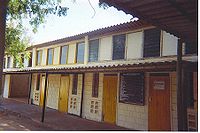
Hola, Kenya
Encyclopedia

Kenya
Kenya , officially known as the Republic of Kenya, is a country in East Africa that lies on the equator, with the Indian Ocean to its south-east...
on the Tana River
Tana River (Kenya)
The long Tana River is the longest river in Kenya, and gives its name to the Tana River District. Its tributaries include the Thika. The river rises in the Aberdare Mountains to the west of Nyeri. Initially it runs east before turning south around the massif of Mount Kenya. The river then runs...
with a population of 6932. Hola is the capital of the Tana River District
Tana River District
Tana River District is a district of Coast Province, Kenya. It is named after the Tana River itself. It has an area of and a population of 180,901 according to the 1999 census. The district capital is Hola ....
, in the Coast Province. It is a busy market town, and portal to Ijara District and Northeastern province by local canoe ferry across the Tana River. In addition to the Hola agricultural irrigation scheme, there is a District Hospital and a Kenya Prisons facility located within the town.
History
Hola was the site of a detention camp Hola massacreHola massacre
The Hola Massacre is an event that took place during the Mau Mau Uprising against British colonial rule at a colonial detention camp in Hola, Kenya.- Event :...
in 1959, where a fracas occurred in which eleven detainees were killed by African prison wardens. The victims were alleged Mau Mau rebels being held in the camp as part of Operation Anvil
Operation Anvil
Operation Anvil may refer to:* the original name for the August 1944 World War II Allied landing in southern France, Operation Dragoon* the military control of Nairobi, Kenya by British security forces from April 24, 1954 in an attempt to sever rebel supply lines during the Mau Mau Uprising*...
. Since the incident there have been efforts to rename the town Galole.
What follows is a recent commentary by a contemporary witness to the Hola investigations:
I, G J Wright, as an Inspector of Police, was sent to Hola a few days after the deaths occurred to relieve the incumbent who was sick. These detainees were not "alleged Mau Mau rebels" but hardcore and recalcitrant criminals who flatly refused to work on an experimental agricultural scheme. The warders, none of who were carrying machine guns, were instructed, perhaps misguidedly, to put the detainees through the motions of work. Some of the detainees attacked the warders with picks and shovels and it was in the resulting melee that some were beaten to death. The deaths were inexcusable but it is worth noting that many of the prison warders had been with the same detainees at Mageta Island in lake Victoria and at Manyani near Voi, and were sorely tried by these thugs. Note too that there were no British Troops in Coast Province and certainly none at Hola at the time of this incident.
There is an alternative historical view of the 'Hola Massacre' in Caroline Elkins
Caroline Elkins
Caroline Elkins is a professor of History at Harvard University. She studies the colonial encounter in Africa during the twentieth century, and the British treatment of the Kikuyu in Kenya....
' Pulitzer Prize-winning book, Imperial Reckoning: The Untold Story of Britain's Gulag in Kenya
Imperial Reckoning: The Untold Story of Britain's Gulag in Kenya
Imperial Reckoning: The Untold Story of Britain's Gulag in Kenya written by Caroline Elkins, published by Henry Holt, won the 2006 Pulitzer Prize for General Non-Fiction. -Commentary and Criticism:...
, (2005), pages 344-353. Much of the story of the British and Colonial administration was covered-up during the transition to independence in Kenya, and many official documents had been intentionally destroyed during the transition. Elkins, by carefully tracing available original documents and interviews with surviving Kenyans and colonial staff, indicates that part of Hola Prison was used as a remote punishment camp for 'hard core' Mau Mau insurgents who refused to recant their oaths or affiliation to the movement. Physical and psychological abuse were used to 'break' detainees, so they could be 'rehabilitated' and moved out of the concentration camp pipeline and back to Kikuyu reservations.
Placed in a hard labor camp, the massacre victims were severely beaten by guards when they refused to work. Official investigations at the time failed to hold any specific prison staff accountable. However, the Hola massacre got the attention of the British cabinet, as the official inquiry indicated very clearly that the detainees were beaten to death, and that the policy towards the detainees had Kenya government approval.
Once the inquiry findings were made public, the opposition members in the House of Commons called for a debate. Increasing adverse publicity and calls for further investigations of human rights abuses in the camps lead to a reduction in UK governmental support for the Kenya Colony's administration, and resulted in accelerated moves towards Kenyan independence.

